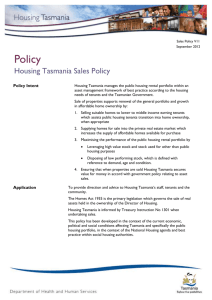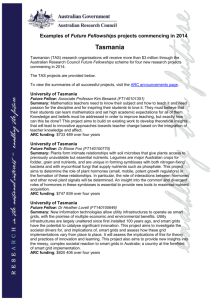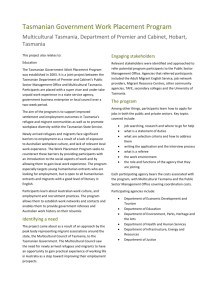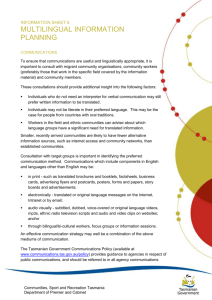Data Centre Action Strategy (511KB WORD)
advertisement
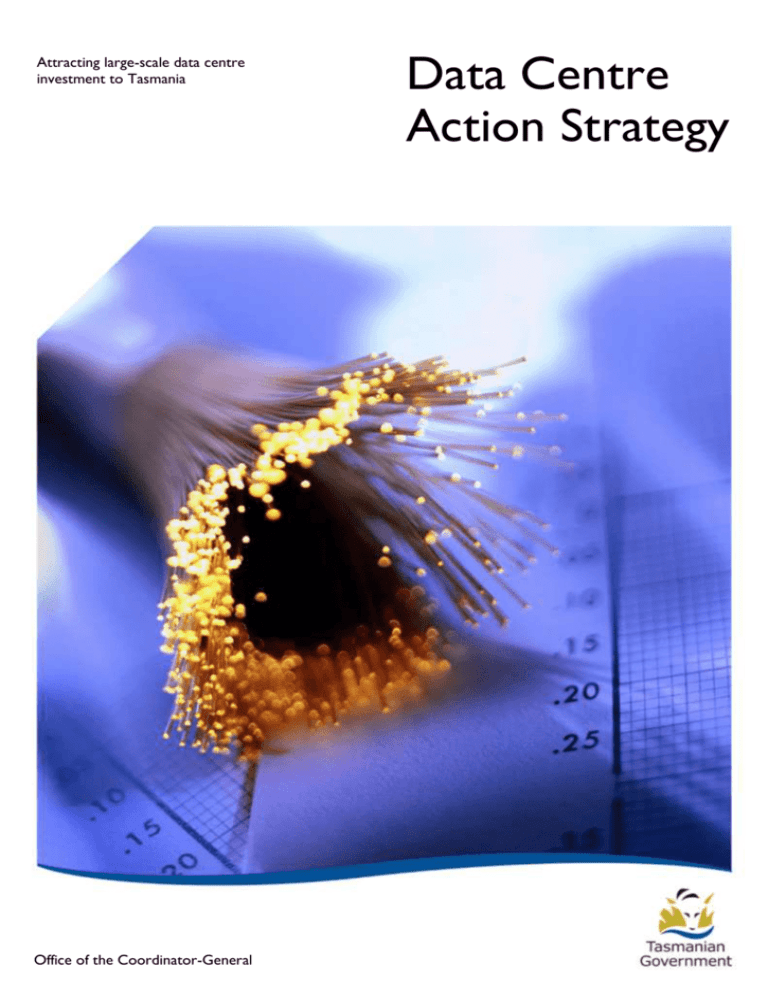
Attracting large-scale data centre investment to Tasmania Document title Office of the Coordinator-General Data Centre Action Strategy 1 Contents Message from the Minister ..........................................................................................................................1 Executive summary .....................................................................................................................................2 Vision and outcomes....................................................................................................................................3 Background ...................................................................................................................................................5 Attracting national and international investment interest......................................................................7 Facilitating a streamlined investment ready position ..............................................................................8 Data Centre Action Strategy i Message from the Minister Information and Communication Technology (ICT) is a vital industry, an enabler of business and service delivery, and capable of playing a transformational role across our economy. IBISWorld predicts that 13 out of Australia’s 19 industry sectors will be either transformed or derive significant benefit from ICT by 2050. To embrace the possibilities of this industry fully, we must think globally. Fuelled by an increasing shift towards cloud computing services, data centres are proliferating and expanding throughout the world with global data centre traffic estimated to grow at a compound annual growth rate of 25 per cent from 2014 to 20191. In Australia, IBISWorld predicts that revenue from data centres will increase by 12.1 per cent annually reaching $1.9 billion by 2021. While there is significant global competition for this investment, Tasmania has key advantages that can differentiate us in attracting data centres to the State. We have a temperate climate reducing cooling costs, ready availability of water at globally competitive prices, and renewable energy offering a strong and cost-competitive alternative for operators wishing to operate in an environmentally sustainable manner. These advantages are already creating interest in Tasmania as a site for data centres. The Tasmanian Government has welcomed the recent proposal by Perth based company, Red Cloud to build a tier-3 data centre in in the State with the company saying Tasmania is the perfect location for this type of investment. This Data Centre Action Strategy outlines the Tasmanian Government's approach to attracting future data centre activities to the State, by promoting Tasmania to data centre investors and facilitating streamlined investment. It builds on the government’s ongoing commitment to growing the ICT industry, including through the decision to fund six contracts valued at $105 million to support vital communications network infrastructure. Work will also continue to support the ICT workforce to enable Tasmania to remain at the very forefront of ICT developments. The Tasmanian Government will continue to work on digital infrastructure options to address any challenges and will maintain a focus on potential solutions to expand and establish digital commercial and infrastructure-related capability to broaden our potential to attract a greater range of data centre investors to the State. We believe the actions outlined in this strategy will provide Tasmania’s best chance of attracting national and international interest in locating data centres in Tasmania. Michael Ferguson MP Minister for Information Technology and Infrastructure 1 Cisco Global Cloud Index: Forecast and Methodology, 2014–2019, White Paper http://www.cisco.com/c/en/us/solutions/collateral/service-provider/global-cloud-indexgci/Cloud_Index_White_Paper.html#Trend5_Network_Speeds_and_Latency Data Centre Action Strategy 1 Executive summary The Tasmanian Government is committed to growing the ICT industry, business competitiveness and efficiency. This Strategy outlines 12 key actions that will encourage national and international investment in data centres in the State. 1. Investigate global trends in relation to the growth and proliferation of data centres and identify key domestic and international companies that are likely to be considering data centre sites. 2. Work with key industry experts and stakeholders to develop a high-level understanding of investment drivers in this sector and undertake a gap analysis in relation to the Tasmanian context. 3. Develop a comprehensive engagement strategy, including promotional material targeted at key companies in the domestic and international data centre industry. 4. Develop quality investment packages that clearly outline Tasmania’s case as an ideal location for a largescale data centre. 5. Engage with the Australian Government for data placement within Tasmania to support investment within the sector. 6. Identify and engage with key intermediaries to help promote data centre investment in Tasmania. 7. In consultation with location experts, develop specific site parameters that influence investment decisions and use these to identify key Tasmanian sites. 8. Work with local government and other stakeholders to progress the investment readiness of the identified sites. 9. Work with major infrastructure and service providers to ensure a whole of government approach to data centre investment 10. Work with education providers including University of Tasmania and TasTAFE to identify any skills gaps and develop strategies to address any identified needs. 11. Continue to monitor and advocate for requisite telecommunications infrastructure. 12. Promote the Office of the Coordinator-General as the single point of contact for data centre market development and investment enquiries, and provide advice to the Minister for Information Technology and Innovation. Tasmania has many characteristics that would make it an ideal home for large-scale data centres. There is already interest in Tasmania as recently demonstrated by Red Cloud, and this Strategy, developed by the Office of the Coordinator-General in conjunction with other stakeholders, will further develop this important area. Interest from international companies in establishing large-scale data centres in Australia is growing and we believe that Tasmania can positively differentiate itself to help drive investment into this area, encouraging major data centre investment. Data Centre Action Strategy 2 Vision and outcomes The Tasmanian Government tasked the Office of the Coordinator-General with attracting a Tier 3 Data Centre to Tasmania, as part of its plan for growing our ICT industry. With the recent announcement by Red Cloud, a Tier 3 data centre now looks likely to occur. This data centre attraction strategy focusses on how we can attract further data centre activity, including large-scale investment. This Strategy outlines key considerations and actions to encourage national and international investment and will guide government direction in proactively facilitating major data centre investment. The attraction of large-scale data centres is a long-term goal. Major data centre investments have long lead times because they require extensive planning and often step-changes in an organisation’s approach to future data needs. This Strategy will predominantly aim at those larger national and international data centre operators that are essentially self-contained with respect to their data usage and demand. There are a number of large national organisations that have large data centre requirements, such as banks and telecommunication companies. Key business requirements include archival and storage, disaster recovery and transaction services. Well known international corporate examples include companies such as Apple, Google, Microsoft, Facebook and Amazon. There are also a large number of specialist data centre providers that are providing services to multiple clients both corporate and public sector. Potential targets will be carefully selected, having regard to likely data usage and technical requirements such as latency and bandwidth. Placing Tasmania on the world map as a suitable location for large-scale data centre investment will be achieved through: working with foreign direct investment experts to understand the global data centre trends and activities and promoting Tasmania globally as a key location for data centres facilitating a streamlined investment ready position working with key stakeholders to ensure that Tasmania is well positioned to respond to interest from national and international companies considering establishing data centres in the State. This strategy is underpinned by a number of existing Government activities to support and grow the Tasmanian ICT industry. Continuing to invest in digital and telecommunications infrastructure to support Tasmania’s ability to compete in the digital economy. Continuing a collaborative approach with industry stakeholders including TasICT, the University of Tasmania and other educational providers to improve resources, education and skills, workforce and commercial services capability, demand and innovation. Continuing to roll out the Cloud Services Strategy, which has seen the Tasmanian Government take the lead in setting policy to achieve the goal of moving whole-of-government data to the Tasmanian Cloud (secure, on-island data centres). This has set an example for other major organisations such as the University of Tasmania, local government and Tasmanian businesses. Data Centre Action Strategy 3 Cross sectoral digital enabling considering big data, emerging technologies, applications and services across all sectors that require core data centre services. (Technology in agriculture/aquaculture, Digital Ready, Sense-T, WiFi initiative, Innovation Incubator). Promoting Tasmania as a place to live and work flexibly. Continuing to work with the Australian Government on the Tasmanian rollout of the National Broadband network (NBN). The Tasmanian Government, in partnership with stakeholders, has also undertaken a number of investigations designed to better understand potential issues and opportunities that may impact potential data centre investment. This underlines the Government’s proactive approach to the development of an informed Data Centre Strategy for Tasmania. Data Centre Action Strategy 4 Background Data centres are a part of everyone’s daily life. Whether you are using social media, searching the internet, buying online, using an ATM or online banking, using government services, booking tickets, streaming movies or using your GPS you are almost certainly using a data centre located somewhere around the world. Data centres store, manage and process digital data at scale and within a specialised, secure, self-contained facility. They underpin modern day ICT services and are the core of modern cloud computing. While data centres can vary dramatically in scale and complexity, there is a growing trend towards developing very large-scale data centres. These can involve significant investment of hundreds of millions of dollars while also offering a range of other important economic benefits. Energy usage can also vary dramatically, typically between 2MW and 50MW, and is a useful indicator of scale. It is generally accepted that the Australian and international data centre industry will continue to expand in line with the increasing demand for internet, data services and the trend towards increased cloud computing services. The proliferation of these services is evident with massive growth in demand being demonstrated by internet services such as Netflix and social media. At the same time, governments and businesses alike are moving services into the ‘cloud,’ adding to increasing demands for data centres. Cloud computing is essentially the storage, management and accessing of data and programs over the internet instead of using local hard drives. Some of the most well-known of these services include Dropbox, Apple’s iCloud and Microsoft’s Cloud platform. The proliferation of cloud services impact activities undertaken by both consumers and businesses every day. While data centre development has predominantly occurred in major cities throughout the United States and Europe, there are increasing examples of major data centre developments spreading to other global locations including more regional destinations. Examples include Google in Chile and Finland and Facebook in Sweden. These investments can drive considerable economic benefits for the chosen location including attracting further major cluster investment in ICT industries and infrastructure including: direct and indirect employment millions of dollars in construction spend demand for highly skilled employees and effective workforce development improved infrastructure likely attraction of related businesses. Energy is one of the biggest expenses in running a data centre and large-scale data centres are large-scale energy users. The Tasmanian energy market is well placed to meet this demand and the desire to attract new load was noted in the recently released Tasmanian Energy Strategy. Data centres in Tasmania can also provide national benefits. There is merit in the Australian Government considering locating its data centre infrastructure in Tasmania, not only for the advantages outlined in this paper, but also in the context of the Australian Government’s commitment to reduce carbon emissions by 26 to 28 per cent by 2030. Greater utilisation of Tasmania’s renewable energy resources by the Australian Government in its activities would contribute to the carbon abatement task. Data Centre Action Strategy 5 The establishment of a large-scale data centre could also create greater economies of scale and support the economic case for additional infrastructure including telecommunications, benefitting all users in Tasmania. There is increasing evidence showing that large-scale data centres can result in attracting and clustering of both other data centres and aligned advanced industries. Examples of this include Hamina, Finland, where Google’s 800 million Euro investment represents one of its largest single foreign greenfield investments and which has led to significant other foreign investments. Large data centre investments are an important signal to other global investors that the location is an attractive place to operate and develop ICT businesses. Companies locating data centres consider a range of factors. These include climate, availability and cost of renewable energy, availability and cost of water, suitability and availability of potential sites, risk, security, skills and labour force, and telecommunications infrastructure. Tasmania has many characteristics that support data centre investment and will provide a competitive platform from which to seek to attract global interest in this growing sector. Tasmania is ideally placed from both a domestic and international perspective through possessing a competitively priced, robust and reliable power system, with over 90 per cent generated from renewable energy sources (hydro and wind). This is even more attractive when considering that Hydro Tasmania also could potentially write contracts with large data centre companies for 100 per cent renewable energy. Hydro Tasmania and TasNetworks are able and willing to offer long term delivered power arrangements, which ensure ongoing certainty for energy users while also benefiting consumers through lowering risks and creating stability in network usage. Tasmania’s temperate climate is relatively unique in the Asia-Pacific region, with its comparatively lower average temperatures through the majority of the year and limited periods of peak summer temperature. Tasmania is one of the most affordable places to do business in Australia, with the lowest aggregate land and accommodation costs in Australia, the lowest business licensing costs in Australia and the lowest tax burden in Australia on most measures. Tasmania has strong labour advantages offering low overall labour costs due partly to its stable workforce and an excellent industrial relations record for minimal days lost to industrial disputes. Australia’s workforce is one of the most highly skilled in the world with competitive remuneration levels that are lower than most comparable markets. Tasmania also has competitive building and construction costs. These include land and construction (site works, base building, and connectivity). Operational costs are also likely to be either similar or cheaper (staffing, water, rates) to other states and regions. Tasmania provides an extremely stable geotechnical environment. Tasmania also provides one of the safest environments in the world from a sovereign risk perspective. Australia (as a country) and Tasmania (as a state) are strongly rated from an external perspective and both have stable overarching government structures. Tasmania has a demonstrated strong research and development focus. Business collaboration, locally, nationally and internationally is a pillar of Tasmania’s success and significant research capabilities existing across a range of sectors including the CSIRO, Australian Antarctic Division, Menzies Research Institute, the Australian Innovation Research Centre and the University of Tasmania. These advantages are enhanced by the political and business environment within Tasmania with the government committed to growing the State’s ICT Industry and infrastructure. The Tasmanian Government owns much of the Data Centre Action Strategy 6 existing energy and telecommunication’s infrastructure including both Hydro Tasmania and TasNetworks, which means these businesses are financially backed by the Crown providing significant investment certainty. It is clear that Tasmania has a lot to offer, with a favourable climate, significant locally produced renewable energy, a range of cost efficient land, abundant water resources, good quality infrastructure and a strong history of innovation and research. Attracting national and international investment interest Over the coming years, the Tasmanian Government will work with sector and foreign direct investment experts to understand global data centre trends and activities and identify and target national and international data centre investment opportunities. Key actions will include: Number Action 1 Investigate global trends in relation to the growth and proliferation of data centres and identify key domestic and international companies that are likely to be considering data centre sites. 2 Work with key industry experts and stakeholders to develop a high-level understanding of investment drivers in this sector and undertake a gap analysis in relation to the Tasmanian context. 3 Develop a comprehensive engagement strategy, including promotional material targeted at key companies in the domestic and international data centre industry. 4 Develop quality investment packages that clearly outline Tasmania’s case as an ideal location for a large-scale data centre. 5 Engage with the Australian Government for data placement within Tasmania to support investment within the sector. 6 Identify and engage with key intermediaries to help promote data centre investment in Tasmania. Data Centre Action Strategy 7 Facilitating a streamlined investment ready position The Tasmanian Government will also work with key stakeholders to ensure that Tasmania is well-positioned for interest from national and international companies considering establishing data centres. The Office of the Coordinator-General will identify sites that are suitable for data centres and work with relevant stakeholders to create an environment that facilitates and supports the establishment of data centres in the State. Key actions will include: Number Action 7 In consultation with location experts, develop specific site parameters that influence investment decisions and use these to identify key Tasmanian sites. 8 Work with local government and other stakeholders to progress the investment readiness of the identified sites. 9 Work with major infrastructure and service providers to ensure a whole of government approach to data centre investment. 10 Work with education providers including University of Tasmania and TasTAFE to identify any skills gaps and develop strategies to address any identified needs. 11 Continue to monitor and advocate for requisite telecommunications infrastructure. 12 Promote the Office of the Coordinator-General as the single point of contact for data centre market development and investment enquiries. Data Centre Action Strategy 8 Office of the Coordinator-General PO Box 1186 Level 1 Cornwall Square 12-16 St John Street Launceston TAS 7250 Data Centre Action Strategy Phone: 03 6777 2786 Fax: 03 6233 5800 Email: cg@stategrowth.tas.gov.au Web: www.cg.tas.gov.au 9
